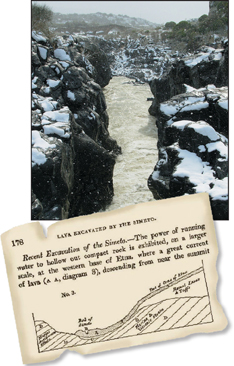Hutton and Geological Change Hutton recognized the connections between a number of geological processes and geological features, like mountains, valleys, and layers of rock that seemed to be bent or folded. Hutton realized, for example, that certain kinds of rocks are formed from molten lava. He also realized that some other kinds of rocks, like those shown in Figure 16–4, form very slowly, as sediments build up and are squeezed into layers.
Hutton also proposed that forces beneath Earth's surface can push rock layers upward, tilting or twisting them in the process. Over long periods, those forces can build mountain ranges. Mountains, in turn, can be worn down by rain, wind, heat, and cold. Most of these processes operate very slowly. For these processes to have produced Earth as we know it, Hutton concluded that our planet must be much older than a few thousand years. He introduced a concept called deep time—the idea that our planet's history stretches back over a period of time so long that it is difficult for the human mind to imagine—to explain his reasoning.
BUILD Vocabulary
ACADEMIC WORDS The noun process means “a series of actions or changes that take place in a definite manner.” The processes that shape Earth are the series of geological actions that do things such as build mountains and carve valleys.
Lyell's Principles of Geology Lyell argued that laws of nature are constant over time and that scientists must explain past events in terms of processes they can observe in the present. This way of thinking, called uniformitarianism, holds that the geological processes we see in action today must be the same ones that shaped Earth millions of years ago. Ancient volcanoes released lava and gases, just as volcanoes do now. Ancient rivers slowly dug channels, like the one in Figure 16–5, and carved canyons in the past, just as they do today. Lyell's theories, like those of Hutton before him, relied on there being enough time in Earth's history for these changes to take place. Like Hutton, Lyell argued that Earth was much, much older than a few thousand years. Otherwise, how would a river have enough time to carve out a valley?
Darwin had begun to read Lyell's books during the voyage of the Beagle, which was lucky. Lyell's work helped Darwin appreciate the significance of an earthquake he witnessed in South America. The quake was so strong that it threw Darwin onto the ground. It also lifted a stretch of rocky shoreline more than 3 meters out of the sea—with mussels and other sea animals clinging to it. Sometime later, Darwin observed fossils of marine animals in mountains thousands of feet above sea level.
Those experiences amazed Darwin and his companions. But only Darwin turned them into a startling scientific insight. He realized that he had seen evidence that Lyell was correct! Geological events like the earthquake, repeated many times over many years, could build South America's Andes Mountains—a few feet at a time. Rocks that had once been beneath the sea could be pushed up into mountains. Darwin asked himself, If Earth can change over time, could life change too?

FIGURE 16–5 A woodcut from Lyell's Principles of Geology shows geological features near Italy's Mount Etna. Among them is a deep channel, labeled “B,” carved into a bed of lava. The channel, shown in the photo, was formed gradually by the movement of water in the Simeto River.
Table of Contents
- Formulas and Equations
- Applying Formulas and Equations
- Mean, Median, and Mode
- Estimation
- Using Measurements in Calculations
- Effects of Measurement Errors
- Accuracy
- Precision
- Comparing Accuracy and Precision
- Significant Figures
- Calculating With Significant Figures
- Scientific Notation
- Calculating With Scientific Notation
- Dimensional Analysis
- Applying Dimensional Analysis




